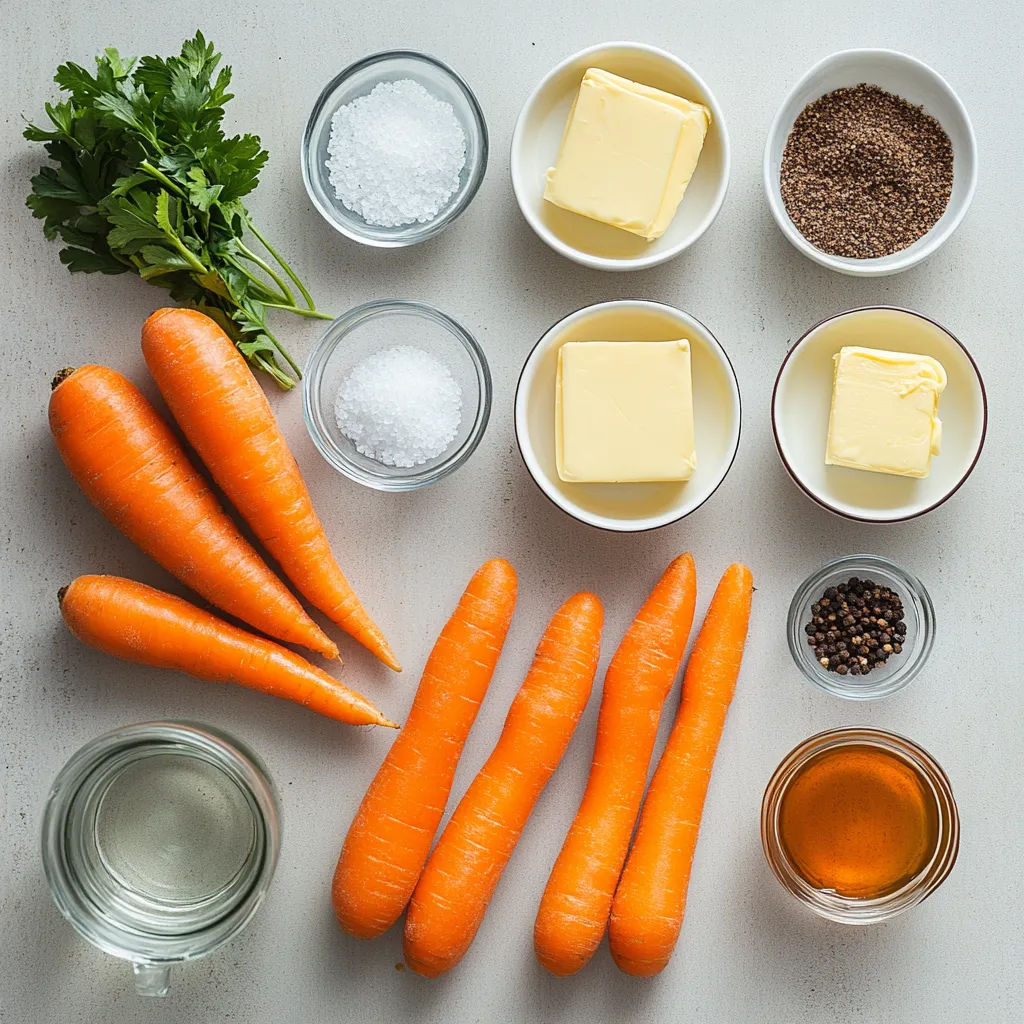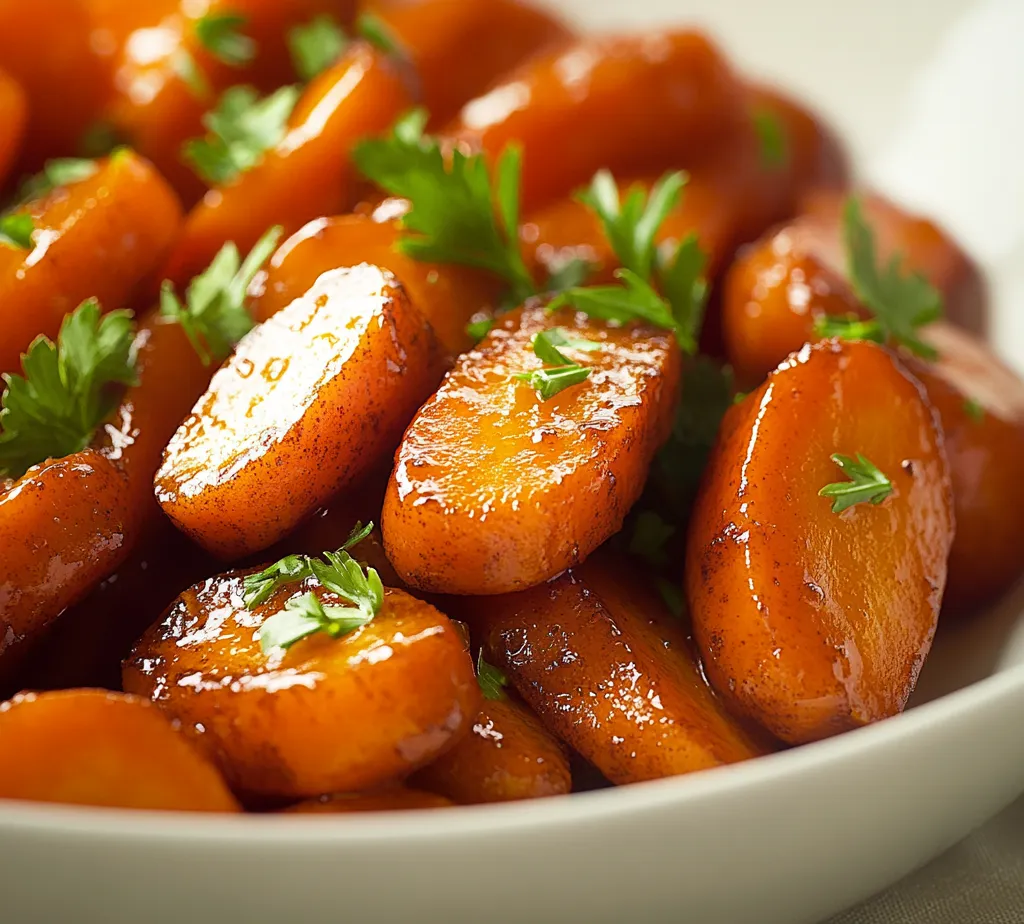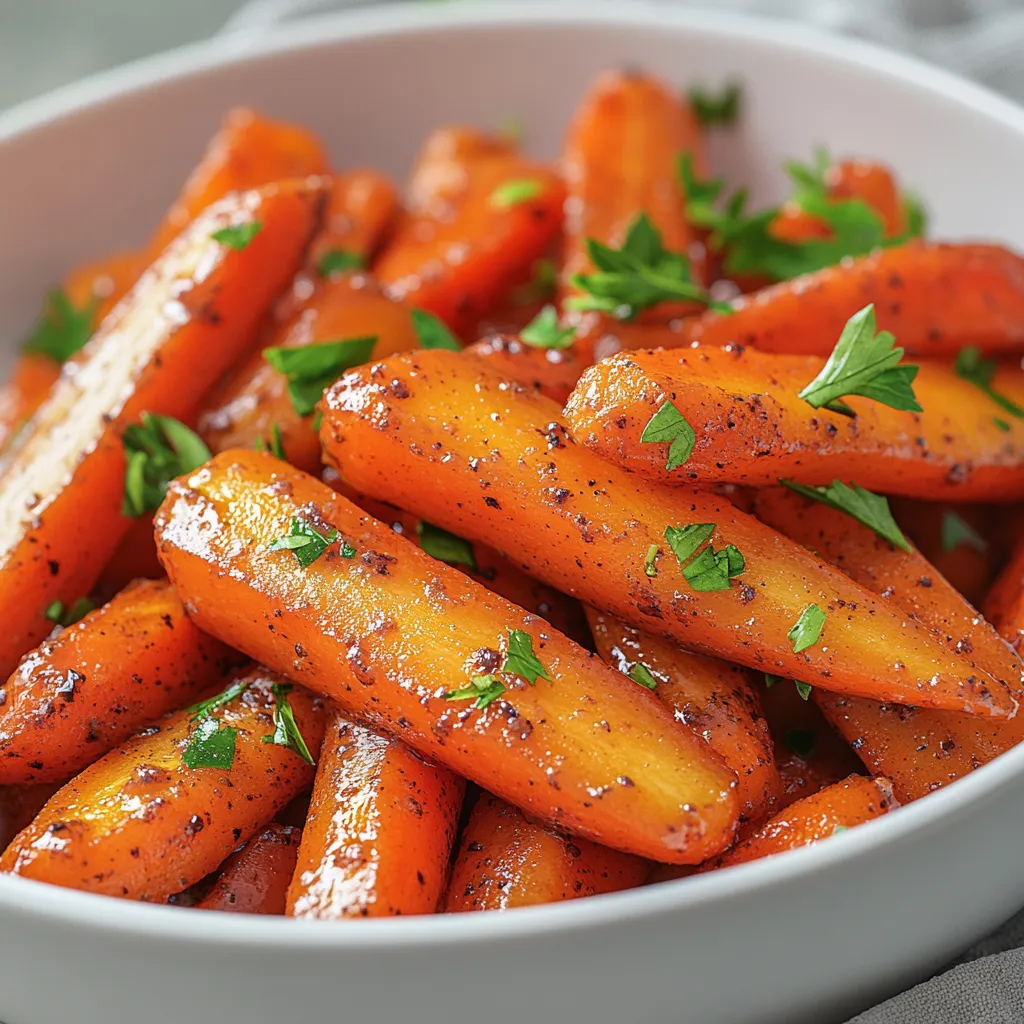Introduction
Brown sugar glazed carrots are a delightful side dish that marries the natural sweetness of carrots with the rich, caramel-like flavor of brown sugar. This simple yet elegant recipe elevates the humble carrot into a sweet and savory delight that can complement a variety of main dishes. The shine and gloss from the glaze, along with the warm hues of cooked carrots, make for a visually appealing presentation on any dining table.
The significance of brown sugar glazed carrots goes beyond their tantalizing taste. They are a favorite not only for their delicious flavor but also for the ease with which they come together, making them a perfect addition to both everyday meals and special occasions. Whether you’re hosting a festive dinner or looking for a nutritious side to accompany a weeknight meal, brown sugar glazed carrots are a dependable choice.
In addition to their delicious flavor, carrots offer numerous health benefits. They’re low in calories, high in fiber, and packed with essential vitamins and minerals, including vitamin A and antioxidants. This makes them an excellent choice for anyone looking to eat healthier while still indulging in comfort food.
Recipe Overview
– Total Time: 30 minutes
– Yield/Servings: 4 servings
– Difficulty: Not specified in the recipe
Brown sugar glazed carrots can serve as a versatile side dish that pairs wonderfully with roasted proteins, grilled dishes, or even as a standout component in vegetarian meals. Their texture is tender with a glossy finish that enhances the overall dining experience.
Ingredients
– 1 pound baby carrots (or regular carrots, sliced into uniform pieces)
– 3 tablespoons unsalted butter
– 1/4 cup packed brown sugar
– 1/2 teaspoon salt
– 1/4 teaspoon freshly ground black pepper
– 1/2 teaspoon ground cinnamon (optional for a warm flavor twist)
– 1/4 cup water
– Fresh parsley, finely chopped (for garnish)
In this recipe, you can choose between baby carrots, which are tender and need no additional preparation apart from rinsing, or regular carrots, which require peeling and slicing to ensure even cooking. The choice of unsalted butter is crucial as it allows for better control of the dish’s overall salty flavor. Brown sugar plays an essential role in creating the sweet glaze that envelops the carrots, providing a rich flavor profile.
The optional ingredient, ground cinnamon, adds depth and warmth to the dish; a hint of spice can make the flavors even more enticing. Fresh parsley is utilized as a garnish, adding a pop of color and a touch of freshness to the finished dish.

Instructions
1. Prepare the Carrots: If you’re using regular carrots, begin by peeling them and slicing them into even-sized pieces for uniform cooking. If baby carrots are your choice, simply rinse them under cold water to remove any dirt.
2. Melt the Butter: Place a large skillet over medium heat and add the unsalted butter. Allow it to melt completely until it starts to foam, releasing a rich aroma.
3. Sauté the Carrots: Introduce the prepared carrots to the skillet. Sauté them for approximately 5 minutes, stirring occasionally, until they begin to soften and develop a slight caramelization.
4. Create the Glaze: In a small mixing bowl, combine the packed brown sugar, salt, black pepper, and ground cinnamon (if using). Gradually stir in the water until the mixture is smooth and well blended.
5. Glaze the Carrots: Carefully pour the brown sugar mixture over the sautéed carrots. Toss gently to ensure each carrot is evenly coated with the sweet glaze.
6. Simmer to Perfection: Lower the heat to a gentle simmer, cover the skillet, and let the carrots cook for about 10-15 minutes. Stir occasionally to prevent sticking, allowing the carrots to become tender and the glaze to thicken beautifully.
7. Garnish and Serve: Once the carrots are tender and the glaze has reached a delightful consistency, remove the skillet from heat. Transfer the glazed carrots to a serving dish and sprinkle with freshly chopped parsley for a vibrant touch before serving.
The sweetness of the brown sugar contrasts beautifully with the natural earthiness of the carrots, creating a well-balanced dish that promises to please.
Preparing the Carrots
When deciding between baby carrots and regular carrots for this recipe, both types have their own advantages. Baby carrots are often sweeter and already cut to a bite-sized dimension, making preparation quicker and easier. On the other hand, if you opt for regular carrots, you’ll want to ensure that they are sliced into even pieces to promote uniform cooking. Not specified in the recipe is the exact size to slice regular carrots, but a thickness of about half an inch is typically recommended.
For preparation, start by peeling regular carrots with a vegetable peeler to remove the skin, which can be tough and not as palatable when cooked. After peeling, cut them into uniform pieces. If you’re using baby carrots, rinse them thoroughly under cold water to ensure any residual dirt is washed away. This preparation step is essential, as it sets the stage for an even cooking process and uniform tenderness in the finished dish.
Melting the Butter
Melted butter serves as the base for sautéing the carrots, enhancing their flavor profile while adding richness to the dish. By using unsalted butter, you have better control over the seasoning of your dish, ensuring that the natural sweetness of the carrots and the brown sugar shine through without being overshadowed by saltiness.
To properly melt the butter, place a large skillet over medium heat. Add the unsalted butter and allow it to melt completely. Watch for the butter to begin foaming, which is an indicator that it is ready for the next step. The lovely aroma that wafts from the pan is an early sign that your dish is on its way to being a delicious reality. Keeping watch at this stage will help prevent the butter from burning, which would impart an unpleasant flavor to the dish.
Sautéing the Carrots
Sautéing is a cooking method that involves cooking food quickly in a small amount of fat over relatively high heat. When you introduce the prepared carrots into the melted butter in the skillet, it’s important to continuously stir them for about 5 minutes. This technique will help develop a slight caramelization on the surface of the carrots, enhancing their natural sweetness and creating a delightful flavor.
When sautéing, ensure you have a large enough skillet to accommodate all the carrots without overcrowding. Overcrowding can lead to steaming instead of sautéing, which prevents the desired caramelization and results in uneven cooking. After around 5 minutes, the carrots should begin to soften, and you may observe some golden brown spots developing on their surfaces, signaling that they are ready for the next phase of treatment—adding and coating them with the sweet brown sugar glaze.

Ensuring the Mixture is Smooth
When combining the brown sugar, salt, black pepper, and any optional spices, it’s essential to achieve a smooth, homogenous mixture. Start by breaking up any clumps in the brown sugar to ensure even dissolving. You can use a fork or a whisk in the mixing bowl to help combine the ingredients effectively. Gradually incorporate the water into the dry mix, stirring continuously to avoid lumps. A smooth glaze will ensure that the carrots are evenly coated, enhancing their flavor.
Optional Cinnamon Incorporation
Incorporating ground cinnamon can add depth to the flavor profile of the brown sugar glaze. Start with the suggested ½ teaspoon; however, feel free to adjust according to your taste preference. If you’re a cinnamon lover, a little extra can emphasize the warmth and sweetness of the dish. Always remember to mix the cinnamon properly to allow its aroma to diffuse throughout the glaze, enhancing the overall experience.
Flavor Benefits of Adding Spice
Spices can greatly enhance the flavor of the glaze, transforming a simple dish into something exceptional. Ground cinnamon, for example, adds a warming note that complements the sweetness of the brown sugar and the earthiness of carrots. Other spices, such as nutmeg or ginger, can also be considered to add a unique twist. Each spice brings its own flavor profile, so experimenting with different combinations can result in a customized dish that suits your palate while still celebrating the essence of the original recipe.
Glazing the Carrots
Pouring the Glaze Effectively
When pouring the prepared glaze over the sautéed carrots, it’s crucial to do so evenly and gradually. This technique prevents any one area from becoming overly saturated, ensuring a balanced flavor distribution across all carrots. Start by drizzling the glaze around the perimeter of the skillet, allowing it to flow naturally to the center before tossing.
Tips for Even Distribution
To achieve an even distribution of the glaze, methodically toss the glazed carrots using a spatula or tongs. Lift and fold the carrots gently rather than stirring vigorously, which may result in breaking them. This technique ensures that each carrot is evenly coated without compromising their shape.
Tossing Techniques for Coating
Tossing the carrots involves a gentle motion that involves flipping them over rather than stirring. Using two utensils or your hands (if safe) can provide better control. Ensure that each carrot is given attention during the tossing process so that the glaze adheres well to the surface, which will enhance the overall flavor and appearance.
How to Ensure Each Carrot is Coated
For perfect coating, inspect each carrot after tossing. If some seem less covered than others, use your spatula to manually coat these areas. You might also consider reintroducing them to the glaze by swirling or gently tossing them back into the skillet until they achieve the desired coverage.
Simmering to Perfection
How to Adjust Heat for Simmering
Once the glaze is added, lowering the heat to a gentle simmer is essential. Too high a heat can result in scorching the glaze or overcooking the carrots, creating a mushy texture. A medium-low setting usually suffices to maintain a simmer without boiling, allowing for thorough cooking.
Covering the Skillet: Benefits and Techniques
Covering the skillet during simmering has multiple benefits, including more even cooking and moisture retention. This technique helps steam the carrots, contributing to their tenderness. You can also slightly offset the lid to release some steam if the glaze becomes too thick, providing flexibility to adjust the consistency.
Duration for Ideal Tenderness
For ideal tenderness, simmer the carrots for about 10 to 15 minutes after glazing. The exact time may vary based on the size and freshness of the carrots. Periodically checking for doneness with a fork can be beneficial; ideally, they should be tender but not falling apart, retaining a pleasant bite.
Stirring Techniques to Prevent Sticking
Occasional stirring is crucial to prevent the carrots from sticking to the skillet base. Use a gentle lifting motion to avoid damaging them while redistributing the glaze. Pay particular attention to the edges, where sticking is more likely to occur, ensuring even cooking throughout.
Expected Changes in Glaze Consistency
As your carrots simmer, you’ll notice the glaze thickening as the moisture evaporates. The final glaze should be syrupy and adhere nicely to the carrots. If it becomes too thick, adding a tablespoon of water can restore some moisture, preventing any burnt or overly concentrated areas.
Garnishing the Dish
Importance of Parsley in Presentation
Finishing your dish with freshly chopped parsley not only adds a pop of color but also brings a fresh herbal taste that nicely contrasts with the sweetness of the glaze. The bright green hue elevates the dish visually, making it more appealing when served.
How to Finely Chop Parsley
To finely chop parsley, start by washing and drying the leaves thoroughly. Gather the leaves into a small bunch, then use a sharp knife to finely mince them. A proper chop not only enhances the presentation but allows the flavor to disperse evenly when added to the dish.
Tips for Plating the Glazed Carrots
When plating your glazed carrots, consider using a shallow bowl or a wide serving plate to showcase the vibrant colors and glossy finish of the glaze. Arrange the carrots in an aesthetically pleasing manner, allowing space for the glaze to pool slightly, enhancing the dish’s overall appearance.
Presentation Techniques for a Shallow Bowl
For an impactful presentation in a shallow bowl, consider layering the carrots to create height within the bowl, allowing the glaze to catch the light. Drizzle extra glaze over the top and garnish with parsley just before serving for a fresh and inviting look.
Optional Visual Enhancements
In addition to parsley, consider adding thinly sliced citrus peel, such as orange or lemon, for a hint of brightness and an elegant touch. Such small additions can elevate the visual appeal and richness of the flavor components in the dish.
Additional Cinnamon Sprinkle
For those who enjoy the flavor of cinnamon, reserving a pinch to sprinkle on top just before serving can be an excellent way to reinforce the warm spice notes. This finishing touch enhances both aroma and visual aesthetics, making the dish appealing at first glance.
Serving Suggestions
Best Accompaniments for Glazed Carrots
These sweet glazed carrots pair wonderfully with various side dishes and entrees. Consider serving them alongside roasted meats, such as chicken or pork, which complement the sweetness of the glaze.
Ideal Protein Pairings
For protein pairings, succulent roasted chicken, herb-crusted pork loin, or even a tender steak can wonderfully enhance the flavors of glazed carrots. The rich, savory profiles of these meats balance the sweet elements beautifully.
Grain Sides that Complement the Dish
To create a rounded meal, consider adding grain sides like fluffy quinoa, wild rice, or creamy mashed potatoes. These sides provide a satisfying contrast in texture while absorbing the excess glaze’s sweetness.
Portion Sizes for Different Occasions
For casual family dinners, serving about ½ cup of glazed carrots per person is typically adequate. However, if served as a celebratory side dish among multiple offerings, consider a smaller portion, around a ¼ cup to allow guests to enjoy various dishes.
Serving for Families versus Large Gatherings
For family meals, a large serving platter allows everyone to help themselves. In contrast, for large gatherings, pre-portioning the glazed carrots into individual servings can add a touch of elegance while also simplifying serving logistics.
Health Benefits of Carrots
Nutritional Profile of Carrots
Carrots are well-known for their nutritional value, being low in calories and high in fiber, making them an excellent choice for healthy eating. A pound of cooked baby carrots can deliver essential vitamins, such as vitamin A, beta-carotene, and potassium, which support vision and overall health.
Antioxidant Properties
Beyond vitamins, carrots are rich in antioxidants, which help combat oxidative stress in the body. This construction contributes to reducing the risk of chronic diseases and enhancing overall immunity.
Health Impacts of Brown Sugar (in moderation)
While brown sugar brings delightful sweetness to the dish, it’s important to consume it in moderation due to its high-calorie content. The molasses in brown sugar does offer trace minerals and antioxidants, but balancing its use within a diet is key to maintaining health.
Variations and Substitutions
Alternatives to Brown Sugar
If brown sugar is not available or suitable, alternatives such as coconut sugar or maple syrup can be used. Both alternatives provide sweetness and a unique flavor, complementing the carrots effectively.
Exploring Different Flavor Profiles
Experimenting with flavored extracts, such as vanilla or almond, can create exciting twists on the classic brown sugar glaze. These flavors can enhance the overall dish, creating a distinctively different version of the recipe.
Replacing Cinnamon with Other Spices
If cinnamon is not to your taste, consider using other warm spices, such as allspice or cardamom, to add depth without altering the overall sweetness. Each spice will impart its nuances, allowing for customization according to preference.
Adding Citrus Zest for a Fresh Twist
Adding a teaspoon of citrus zest (like orange or lemon) can introduce a bright note to the dish, cutting through some of the sweetness while enhancing complexity. Just be sure to mix it in well with the glaze for even incorporation.
Suggestions for Including Other Vegetables
To make the dish more substantial, consider including additional vegetables such as parsnips or sweet potatoes. Cut them into similar sizes for uniform cooking. This variation can provide a delightful mixed vegetable medley alongside the carrots.
Conclusion
Brown Sugar Glazed Carrots present a balance of sweetness and tender texture, making them an excellent companion to many dishes. With a preparation time of just 30 minutes, this dish is straightforward yet elegant, enhancing any meal with its vibrant colors and delightful flavors. The careful balance of spiciness and sweetness creates an appealing side that is sure to please any palate.

Sweet Harmony: Brown Sugar Glazed Carrots
Ingredients
- 1 pound baby carrots
- 3 tablespoons unsalted butter
- ¼ cup packed brown sugar
- ½ teaspoon salt
- ¼ teaspoon freshly ground black pepper
- ½ teaspoon ground cinnamon
- ¼ cup water
- fresh parsley finely chopped
Instructions
- Prepare the carrots by peeling and slicing regular carrots or rinsing baby carrots.
- Melt the butter in a large skillet over medium heat until foamy.
- Sauté the carrots for about 5 minutes until they soften and caramelize slightly.
- In a small bowl, mix brown sugar, salt, black pepper, and cinnamon.
- Stir in water until the mixture is smooth.
- Pour the brown sugar mixture over the sautéed carrots and toss to coat.
- Lower the heat, cover, and simmer for 10-15 minutes, stirring occasionally.
- Once tender, remove from heat and transfer to a serving dish.
- Garnish with freshly chopped parsley before serving.

